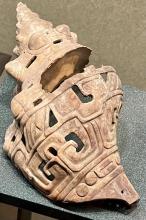tecciztli (Mdz67r)
This example of iconography from the Codex Mendoza is meant to provide a comparison for conch shells (tecciztli). The contextualizing image shows the enormous size of this one. As the Codex Telleriano-Remensis and Codex Azcatitlan additionaly show, the tecciztli can sometimes be shown as a cut-away, revealing the interior coils.
Stephanie Wood
A sign next to a tecciztli at the Templo Mayor refers to the shell as a "turbinella angulata" and a large "gastropod shell...from the Atlantic coast of Mexico." It continues, "The presence of several specimens of the periostracum, a protein layer that covers the shell's surface, attests to the fact they were collected alive by divers, because this layer is lost when the animal dies in the sea and is dragged onto the beach by the swell of waves. A specimen of this species was found covered with blue pigment, perhaps to emphasize its relationship with water, in one of the offerings dedicated to Tlaloc. It also served for the production of a large number of objects including the ehecacozcatl, the pectoral characteristic of the god Ehecatl-Quetzalcoatl, which is produced by transversally cutting the shell's spiral whorls. Beads and pendants made of this shell have also been found."
Stephanie Wood
c. 1541, or by 1553 at the latest
Stephanie Wood
shells, conchas, caracoles
This beautifully carved Post-Classic conch shell was found in Michoacan. Museo Nacional de Antropología e Historia, Sala 10. Photo by S. Wood, 30 April 2025.
tecciz(tli), conch shell/trumpet, https://nahuatl.wired-humanities.org/content/tecciztli
la concha
Codex Mendoza, folio 67 recto, https://digital.bodleian.ox.ac.uk/objects/2fea788e-2aa2-4f08-b6d9-648c00..., image 144 of 188.
Original manuscript is held by the Bodleian Libraries, University of Oxford, MS. Arch. Selden. A. 1; used here with the UK Creative Commons, “Attribution-NonCommercial-ShareAlike 3.0 License” (CC-BY-NC-SA 3.0)






